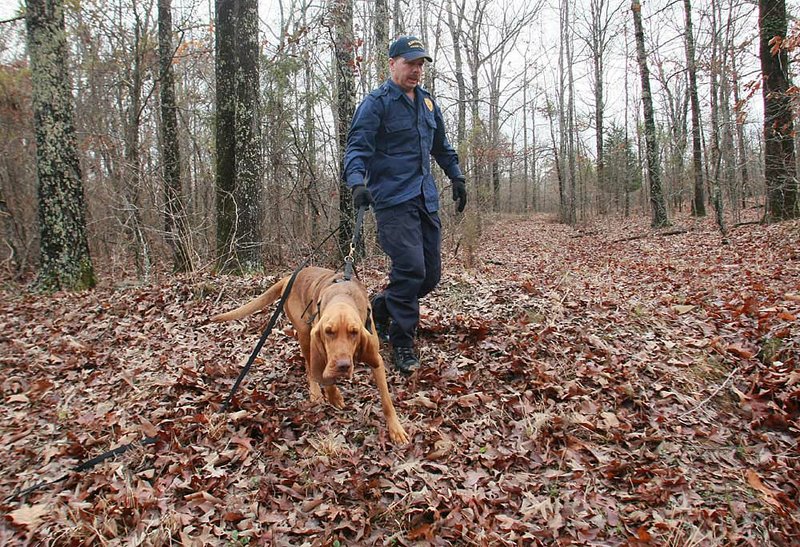LITTLE ROCK — While their two older teammates relaxed nearby, 8-month-old beagle pups Lady Bug and Little Man jumped and howled after their first ever competitive run during the 12th annual Southern States Manhunt Field Trials held Wednesday at Camp Robinson.
Florida’s Escambia County Road Prison team, one of 24 tracking-dog teams from across the South in the week long competition, had just finished following a scent and made a capture in just 19 minutes, 24 seconds.
One of that team’s handlers, Chad Sims, said the competition, being hosted by the Arkansas Department of Correction, helps keep the dogs sharp for when they’re needed in a real emergency.
“You learn something every time you run,” Sims said. “It’s more education than anything.”
The competition pits prison workers and law enforcement officers in various dog events involving drugs, tracking and handguns.
Though tracking dogs are commonly associated with hunting escaped prisoners, said Shea Wilson, communications administrator for the Department of Correction, they are often also used in community outreach.
“We use our teams all the time to assist law enforcement outside of the prison,” Wilson said. “It’s not just the old-time thought of a dog tracking someone who broke out of prison.”
The tracking-dog teams are divided into two competition categories: dogs on leashes and pack dogs. The packs consist of 10-15 loose dogs followed by handlers on horseback. Each team gets 1 1/2 hours to track during the day and during the night.
Plaques will be given to top performers at the end of the week, said John Kleiner, vice president of the manhunt trials organization and emergency management administrator at the state Correction Department.
The tracking events give handlers an opportunity to improve and learn new ways of training their dogs.
“It’s an exchange of ideas and techniques,” said Kyle Moody, a field sergeant who works with tracking dogs at the North Central Prison Unit in Calico Rock.
Kleiner said there are 12 lockups in Arkansas that have tracking dogs, which are frequently called out to assist with anything from finding a live person to finding a body.
“They’re utilized for the apprehension of criminals, to find Alzheimer’s patients, lost children,” Kleiner said. “The big deal is these dogs hunt the hottest scent.”
The dogs are usually taken to a missing person’s last-known location to pick up the scent, Kleiner said. The dogs then “work off the ground,” detecting a scent from footprints, physical disturbances in the vegetation and even dead skin, he said.
The dogs can also be used to find victims of natural disasters, Kleiner said.
A few weeks ago, Wilson said, the North Central Unit tracking dogs helped the Izard County sheriff’s office hunt a suspect.
“They had a suspect they couldn’t find in the woods behind a house in Heber Springs ... and the dogs found him,” Wilson said.
Moody said his unit at Calico Rock has its own breeder and kennel, similar to many other units throughout Arkansas. Bloodhound is the most common tracking-dog breed, and is often mixed with various types of coonhounds, including treeing walkers, redbones or blueticks, Moody said.
Puppies begin training at a couple of months old, starting out with simple, half-mile tracks laid out on prison grounds, Moody said.
Each dog responds differently to training. Older, more experienced dogs are better trackers, Moody said. There are exceptions, though, like Liv, a 2-year-old bloodhound mix.
“She’s our No. 1 dog,” Moody said. “She made her first real catch at 9 months old.”
There’s no age limit on the working dogs, but if a dog becomes “slow” as it gets older, it will not be taken out on calls, Moody said. Once a dog is retired, it stays at the kennel and continues to run on the prison tracks, he said.
Moody, one of several handlers who works with about eight dogs at the prison, said daily training is important so that handlers can understand their dogs’ mannerisms when they’ve found their targets.
“Some dogs wag their tail, lift their head up, they act differently,” Moody said. “Every dog has different body language.”
Over the years, the dogs have mellowed, Kleiner said.
“If you roll the clock back a long time ago, the dogs did bite” when they found an escaped prisoner, but because the dogs are now often used for finding noncriminals, they are no longer trained to be aggressive, he said.
Though most of the tracking dogs are trained at prisons, South Arkansas Youth Services - which houses youthful offenders - has tracking dogs in Lewisville and Mansfield, said Robert Wood, a dog handler at Mansfield.
“We try to make our training simulate what we’d see in the field,” Wood said.
The dogs are used to catch runaway youthful offenders, but Woods said they more often assist law enforcement in nearby counties, including Franklin, Scott and Logan. “Their assignments range from finding criminals to locating missing hunters.
Wilson said tracking dogs continue to be invaluable for law enforcement.
“[Tracking dogs] aren’t on people’s minds until something tragic happens like a child is lost or a hunter is lost in the woods,” Wilson said. “When that happens, you really appreciate these guys and their dogs.”
Arkansas, Pages 9 on 03/10/2011

